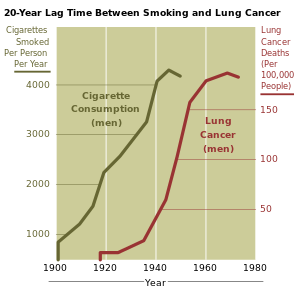causes of lung cancer
The main causes of lung cancer (and cancer in general) include carcinogens (such as those in tobacco smoke), ionizing radiation, and viral infection. This exposure causes cumulative changes to the DNA in the tissue lining the bronchi of the lungs (the bronchial epithelium). As more tissue becomes damaged, eventually a cancer develops.[5]
Smoking
Smoking, particularly of cigarettes, is by far the main contributor to lung cancer.[30] Across the developed world, almost 90% of lung cancer deaths are caused by smoking.[31] In the United States, smoking is estimated to account for 87% of lung cancer cases (90% in men and 85% in women).[32] Among male smokers, the lifetime risk of developing lung cancer is 17.2%; among female smokers, the risk is 11.6%. This risk is significantly lower in nonsmokers: 1.3% in men and 1.4% in women.[33] Cigarette smoke contains over 60 known carcinogens,[34] including radioisotopes from the radon decay sequence, nitrosamine, and benzopyrene. Additionally, nicotine appears to depress the immune response to malignant growths in exposed tissue.[35]
The length of time a person smokes (as well as rate of smoking) increases the person's chance of developing lung cancer. If a person stops smoking, this chance steadily decreases as damage to the lungs is repaired and contaminant particles are gradually removed.[36] In addition, there is evidence that lung cancer in never-smokers has a better prognosis than in smokers,[37] and that patients who smoke at the time of diagnosis have shorter survival times than those who have quit.[38]
Passive smoking—the inhalation of smoke from another's smoking—is a cause of lung cancer in nonsmokers. A passive smoker can be classified as someone living or working with a smoker as well. Studies from the U.S.,[39] Europe,[40] the UK,[41] and Australia[42] have consistently shown a significant increase in relative risk among those exposed to passive smoke. Recent investigation of sidestream smoke suggests that it is more dangerous than direct smoke inhalation.[43]
Radon gas
Radon is a colorless and odorless gas generated by the breakdown of radioactive radium, which in turn is the decay product of uranium, found in the earth's crust. The radiation decay products ionize genetic material, causing mutations that sometimes turn cancerous. Radon exposure is the second major cause of lung cancer, after smoking.[9] Radon gas levels vary by locality and the composition of the underlying soil and rocks. For example, in areas such as Cornwall in the UK (which has granite as substrata), radon gas is a major problem, and buildings have to be force-ventilated with fans to lower radon gas concentrations. The United States Environmental Protection Agency (EPA) estimates that one in 15 homes in the U.S. has radon levels above the recommended guideline of 4 picocuries per liter (pCi/L) (148 Bq/m³).[44] Iowa has the highest average radon concentration in the United States; studies performed there have demonstrated a 50% increased lung cancer risk, with prolonged radon exposure above the EPA's action level of 4 pCi/L.[45][46]
Asbestos
Asbestos can cause a variety of lung diseases, including lung cancer. There is a synergistic effect between tobacco smoking and asbestos in the formation of lung cancer.[10] In the UK, asbestos accounts for 2–3% of male lung cancer deaths.[47] Asbestos can also cause cancer of the pleura, called mesothelioma (which is different from lung cancer).
Viruses
Viruses are known to cause lung cancer in animals,[48][49] and recent evidence suggests similar potential in humans. Implicated viruses include human papillomavirus,[50] JC virus,[51] simian virus 40 (SV40), BK virus, and cytomegalovirus.[52] These viruses may affect the cell cycle and inhibit apoptosis, allowing uncontrolled cell division.



0 Comments:
Post a Comment
Subscribe to Post Comments [Atom]
<< Home